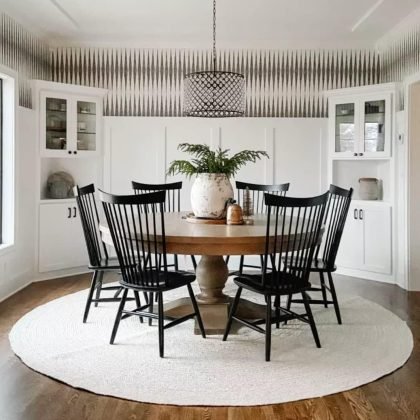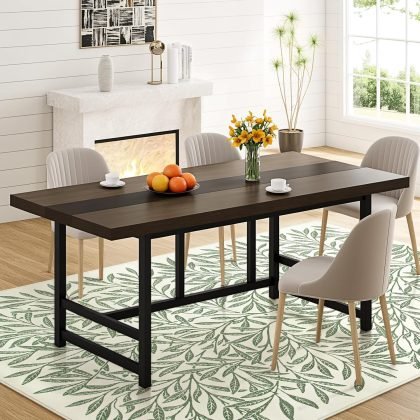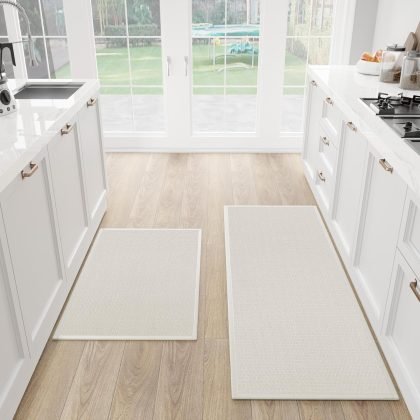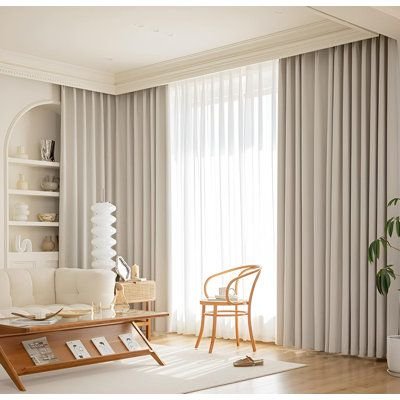Introduction
Choosing the perfect rug for every room can transform any space in your home. Whether you are looking to add warmth to your living room, comfort to your bedroom, or style to your dining area, the right rug not only serves a functional purpose but also enhances the aesthetic appeal of your home. Here, we will guide you on how to pick the perfect rug for every room, considering factors such as style, size, and material to ensure it meets both your decorative and practical needs.
Follow us on Pinterest
Here is the Complete Guide for each room
1. Living Room Rugs: Enhancing Style and Comfort
When selecting a rug for your living room, you want to choose something that both complements your furniture and adds a cozy atmosphere. A large area rug is a great option to tie the entire room together. Opt for rugs made of wool or jute, as they offer durability and softness, making them ideal for high-traffic areas.
For a more modern look, consider geometric patterns or abstract designs that can bring an artistic flair to your space. If your living room has neutral tones, a rug with bold colors can serve as the perfect focal point. Alternatively, if your space already has a lot of patterns, a solid-colored rug will create a balanced look.
Key Benefits of Living Room Rugs:
- Adds warmth and texture to hardwood or tile floors.
- Protects flooring from furniture and foot traffic.
- Defines seating areas, making the room feel more organized.
2. Bedroom Rugs: Comfort Meets Elegance
The bedroom is where you unwind, so a soft, plush rug is essential to create a calm and inviting space. Shag rugs or plush wool rugs work beautifully in bedrooms, offering a luxurious feel underfoot. Consider placing a rug beneath the bed, extending outward to create a layered look. A sheepskin rug beside your bed can also add an extra element of comfort when you wake up.
When choosing a rug for your bedroom, select colors that complement your bedding and decor. Soft, muted shades like cream, gray, or pastel tones can help create a serene environment. Rugs made from natural fibers are ideal, as they offer breathability and softness, making them perfect for bedrooms.
Key Benefits of Bedroom Rugs:
- Creates a plush surface for bare feet in the morning.
- Dampens sound, making the room quieter and more peaceful.
- Adds warmth to your floors, especially during colder months.
3. Dining Room Rugs: Functionality with Flair
The rug you choose for your dining room needs to be practical, as it will be exposed to food spills and frequent use. A flat-weave rug or a low-pile rug is an excellent option because they are easy to clean and maintain. Look for materials such as polypropylene or cotton that can handle spills and stains without losing their charm.
In terms of size, make sure the rug is large enough to accommodate your dining table and chairs. The general rule is that the rug should extend at least 24 inches beyond the table to allow space for chairs to move in and out easily. A patterned rug can hide stains and add visual interest to a more traditional dining area, while a neutral rug can offer a subtle backdrop for a more modern setting.
Key Benefits of Bedroom Rugs:
- Protects the floor from spills and scratches from chairs.
- Defines the dining space, especially in open-plan homes.
- Adds texture and color to complement your dining set.
4. Hallway and Entryway Rugs: First Impressions Matter
Your hallway or entryway is the first space guests see when they enter your home, making it crucial to choose a rug that sets the tone for the rest of your home’s design. Runner rugs are perfect for these narrow spaces, providing warmth and decoration. Choose a durable material like sisal, jute, or nylon, which can withstand the heavy foot traffic typical in entryways.
For style, opt for a striped rug to elongate the hallway or a patterned rug to hide dirt and wear. Neutral tones work well in entryways, but don’t be afraid to add a pop of color for personality.
Key Benefits of Hallway Rugs:
- Protects your flooring from wear and tear.
- Defines the path, leading visitors smoothly through your home.
- Adds a welcoming element, enhancing the entrance experience.
5. Kitchen Rugs: Adding Comfort and Style
The kitchen might not be the first place you think of when choosing a rug, but it can benefit greatly from a well-placed one. Anti-fatigue mats or washable rugs can provide comfort when standing for long periods while cooking. Choose water-resistant materials such as cotton or nylon for durability. Rugs with rubber backing are also a good option to prevent slipping in a high-traffic, spill-prone area like the kitchen.
Rug patterns and colors should complement your kitchen decor. A bright, patterned rug can inject energy into the room, while a more neutral, understated rug can create a sense of calm in a busy space.
Key Benefits of Kitchen Rugs:
- Provides comfort while standing for long periods.
- Adds warmth and color to a functional space.
- Protects the floor from spills and wear.
Conclusion
Selecting the perfect rug for each room in your home is about more than just aesthetics; it’s about functionality, comfort, and enhancing your space. From cozy bedroom rugs to durable dining room options, rugs are versatile pieces that can transform any room in your home.
By considering the style, material, and size, you can find the right rug to meet the unique needs of each room. Whether it’s a plush shag rug for your bedroom or a flat-weave rug for the dining area, the right choice will bring both comfort and style into your living spaces.
Follow us on Pinterest
FAQs
1. What type of rug is best for living rooms?
The best rugs for living rooms are large area rugs made of durable materials like wool or jute. These rugs add warmth, define seating areas, and protect your floors from high foot traffic while enhancing the room’s aesthetic.
2. How do I choose the right size rug for my dining room?
For a dining room, choose a rug that extends at least 24 inches beyond the edges of the table, allowing enough space for chairs to move in and out easily. A flat-weave or low-pile rug is ideal for easy maintenance and durability.
3. What type of rug is best for bedrooms?
For bedrooms, opt for plush wool rugs or shag rugs to add comfort and softness underfoot. Placing the rug under the bed and extending it outward creates a cozy, layered look while enhancing the room’s warmth and tranquility.
4. Which rugs are easy to clean for a kitchen?
The best rugs for kitchens are water-resistant and washable rugs made from materials like cotton or nylon. Look for rugs with a rubber backing to prevent slipping and ensure easy maintenance in high-traffic areas.
5. How do I choose a rug for a high-traffic entryway or hallway?
For entryways and hallways, choose runner rugs made of durable materials like sisal, jute, or nylon. These rugs can withstand heavy foot traffic, protect your floors, and add an inviting element to your home’s entrance.
6. What are the benefits of using rugs in different rooms?
Rugs provide numerous benefits, including adding warmth, protecting floors, reducing noise, and defining spaces. Whether in the living room, bedroom, dining area, or kitchen, a well-chosen rug enhances both functionality and style in every room.









